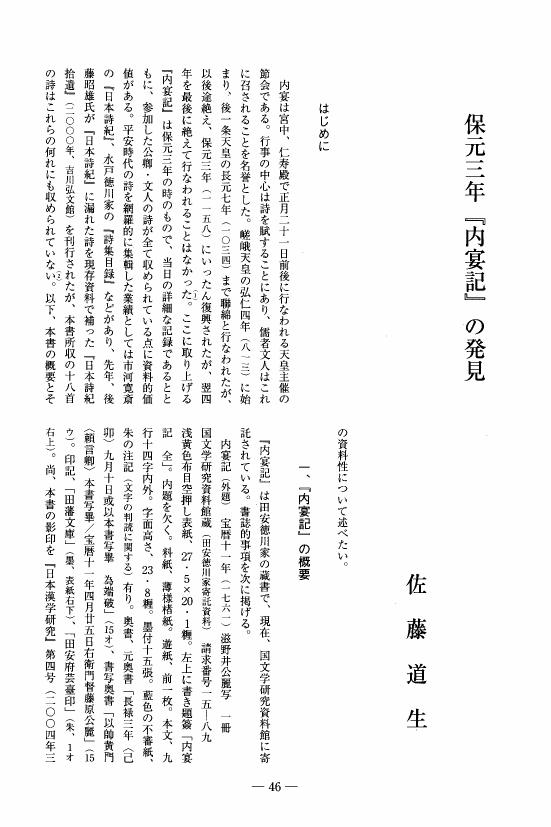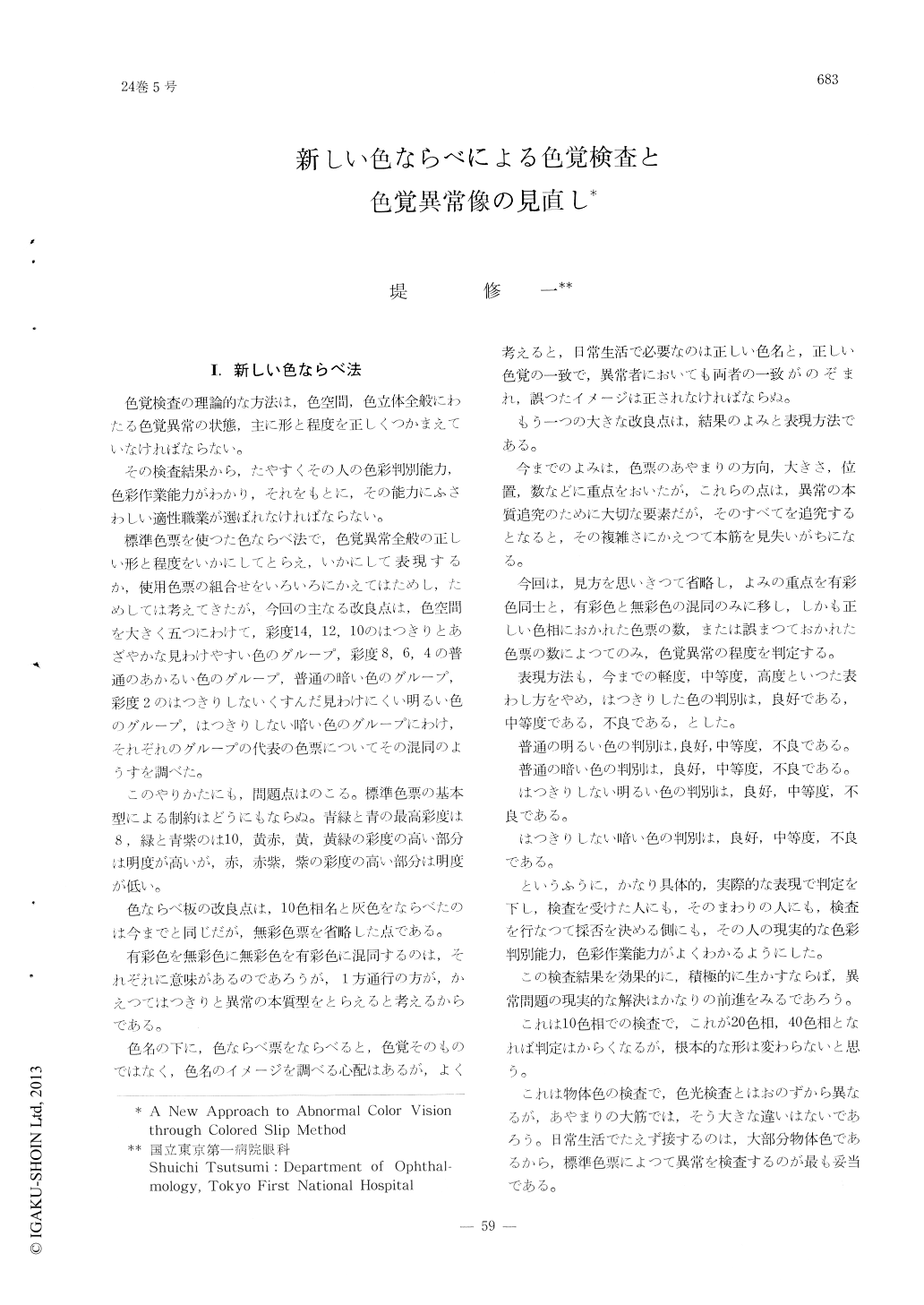1 0 0 0 OA 保元三年『内宴記』の発見
- 著者
- 佐藤 道生
- 出版者
- 中世文学会
- 雑誌
- 中世文学 (ISSN:05782376)
- 巻号頁・発行日
- vol.49, pp.46-55, 2004 (Released:2018-02-09)
1 0 0 0 田安徳川家蔵『内宴記』(前半)の翻字と訓読
- 著者
- 佐藤 道生 堀川 貴司
- 出版者
- 佐藤道生
- 雑誌
- 日本漢学研究 (ISSN:13464639)
- 巻号頁・発行日
- no.4, pp.13-19, 2004-03
- 著者
- 乾 克己
- 出版者
- 学灯社
- 雑誌
- 国文学 解釈と教材の研究 (ISSN:04523016)
- 巻号頁・発行日
- vol.25, no.11, pp.p68-71, 1980-09
1 0 0 0 IR 萩藩江戸屋敷裏御殿と長局の変遷
- 著者
- 高屋 麻里子
- 雑誌
- 東京造形大学研究報 = Journal of Tokyo Zokei University
- 巻号頁・発行日
- no.18, pp.16-23, 2017-03-31
1 0 0 0 新しい色ならべによる色覚検査と色覚異常像の見直し
1 0 0 0 OA 色ならべ色覚検査法による異常の精密判定
- 著者
- 堤 修一
- 出版者
- 一般社団法人 国立医療学会
- 雑誌
- 医療 (ISSN:00211699)
- 巻号頁・発行日
- vol.24, no.10, pp.759-772, 1970-10-20 (Released:2011-10-19)
This color sense anomaly test can investigate precisely the intensity, form and locality of the color sense anomaly, in the whole color sense space.This test can determine precisely the color sense anomaly grade, form and inclination.
1 0 0 0 IR 横笛「青葉」伝承の生成と流布
- 著者
- 妹尾 恵里
- 出版者
- 武庫川女子大学大学院文学研究科
- 雑誌
- 日本語日本文学論叢 (ISSN:1881476X)
- 巻号頁・発行日
- no.13, pp.17-35, 2018-02
1 0 0 0 OA 浸漬処理を用いた高カルシウム含量水耕レタスの生産について
- 著者
- 井上 興一 近藤 悟 真部 孝明 横田 弘司
- 出版者
- Japanese Society of Agricultural Technology Management
- 雑誌
- 農業生産技術管理学会誌 (ISSN:13410156)
- 巻号頁・発行日
- vol.3, no.2, pp.1-7, 1996-10-01 (Released:2019-04-17)
水耕で栽培したレタスの根を種々の濃度を変えたCaCl_2およびCa(NO_3)_2の高濃度単一溶液に48時間浸し,葉部におけるCaおよびClあるいはNO_3の増加の有無を検討した。外葉および内葉のCa含有率は,処理溶液のCa濃度の増加に伴い増加し,この増加したCaの大部分は水溶性Caであった。葉部Ca含有率は,CaCl_2処理区においてCl含有率との間に,Ca(NO_3)_2処理区においてはNO_3含有率との間に1%レベルで有意の相関が認められた。硝酸カルシウムの処理は葉部Ca含量の増加に伴い,多量のNO_3も集積するので,本浸漬処理には不適当と判断された。また,処理液のCa濃度が40mM付近であれば葉部の萎凋や障害を発現させずにCa含有率を著しく増加させることが認められた。塩化カルシウム処理のCa40mM区の葉部Ca含有率は1.95gkg^<-1>・新鮮重であり,この値は対照区の(0.75gkg^<-1>・新鮮重)2.6倍であった。
- 著者
- 仲辻 真帆
- 出版者
- 日本音楽学会
- 雑誌
- 音楽学 (ISSN:00302597)
- 巻号頁・発行日
- vol.65, no.1, pp.32-49, 2019 (Released:2020-10-15)
東京音楽学校本科(現在の東京藝術大学音楽学部)において体系的な作曲教育が開始されたのは、1931(昭和6)年のことである。時勢に鑑みて、文部省令により「作曲部」が設置された。東京音楽学校の作曲教育は、日本における創作領域の人材育成に大きく寄与してきたにもかかわらず、これまで本格的な研究がなされてこなかった。本論文は、この本科作曲部の最初期の様相解明を目的としている。 1932年より本科作曲部の入学者が募集され、設置当初は毎年2~3人の作曲専攻の学生が入学した。信時潔、片山頴太郎、下總皖一、呉泰次郎の他、外国での研鑽を終えたばかりの細川碧や橋本國彦、ドイツ音楽を体得していたK. プリングスハイムも指導にあたった。ドイツやウィーンの音楽理論の教授が根幹にあったが、和歌への作曲や律旋法・陽旋法など日本の伝統的音階に基づく作曲も実施されていた。教員たちが自ら翻訳したテクストを用いるなど独自の音楽理論を展開していたことも明らかとなった。 本研究では、学校資料に基づいてカリキュラムや試験問題を提示するとともに、1930年代に在学していた学生たちの手稿資料を活用して授業内容を検証した。とりわけ自筆譜、日記、書簡からは、ソナタの作曲に苦悶しながら、朝夕問わず日々習作を書いて作曲修得に励んでいた学生たちの様子が浮き彫りとなった。S. ヤーダスゾーンの『和声学教科書』が受験勉強に用いられていたこと、作曲部の授業でS. クレールやH. リーマンの和声論が教授されていたことも判明し、そこから昭和初期の和声教育の一端が見出された。 研究対象とした1930年代は、社会状況が激しく変化した時期である。作曲部の学生たちも軍事訓練への参加や戒厳令下での合唱練習を経験していた。ただし戦争の影響はまだ大きくなく、設置当初の作曲部では充実した授業が実施されていた。初期卒業生の記述からは、新体制の中で豊かな作曲教育を享受していたことがわかる。
1 0 0 0 IR 日系「二世」たちと沖縄戦 : 古処誠二『接近』をめぐって (大城學先生退職記念号)
- 著者
- 仲程 昌徳 Nakahodo Masanori
- 出版者
- 琉球大学法文学部
- 雑誌
- 琉球アジア文化論集 : 琉球大学法文学部紀要 : bulletin of the Faculty of Law and Letters, University of the Ryukyus (ISSN:21888043)
- 巻号頁・発行日
- no.4, pp.41-54, 2018-03
- 著者
- 谷村 英洋 小島 佐恵子 日下田 岳史 橋本 鉱市
- 出版者
- 大正大学エンロールメント・ マネジメント研究所
- 雑誌
- エンロールメント・マネジメントとIR = Enrollment Management and Institutional Research (ISSN:24351628)
- 巻号頁・発行日
- no.2, pp.105-116, 2021-03-31
1 0 0 0 呉・戦災と復興 : 旧軍港市転換法から平和産業港湾都市へ
1 0 0 0 OA 評価に晒されること,覚悟をもつこと
- 著者
- 黒沢 幸子
- 出版者
- 日本ブリーフサイコセラピー学会
- 雑誌
- ブリーフサイコセラピー研究 (ISSN:18805132)
- 巻号頁・発行日
- vol.25, no.1-2, pp.30-32, 2017-03-31 (Released:2017-06-30)
- 参考文献数
- 3
- 著者
- 金子 八重子
- 出版者
- 日本看護協会出版会
- 雑誌
- 看護 : 日本看護協会機関誌 (ISSN:00228362)
- 巻号頁・発行日
- vol.66, no.6, pp.73-75, 2014-05
- 著者
- 後藤 千夏 瀬口 哲夫
- 出版者
- 日本建築学会
- 雑誌
- 日本建築学会計画系論文集 (ISSN:13404210)
- 巻号頁・発行日
- vol.75, no.654, pp.1855-1863, 2010-08-30 (Released:2010-10-08)
- 参考文献数
- 17
- 被引用文献数
- 1 2
This study clarifies the actual situation about succession of Rikyu's idea and originality of modern Taian Utsushi. In Taian Usushi, the suitable designs for the modern tea ceremony in addition to the basic designs of Taian that succeed Rikyu's ideas are reproduced. And it is divided into the reproduction type, the type of valuing historical materials, and the restoration type. If a designer thinks Taian is based on Rikyu's idea, it becomes the reproduction type or the type of valuing historical materials. If a designer doesn't think Taian is based on Rikyu's idea so much, it becomes the restoration type.
1 0 0 0 OA 日本における家庭支援の一起源-河田嗣郎の所説を中心に-
- 著者
- 大城 亜水
- 出版者
- 神戸常盤大学・神戸常盤大学短期大学部
- 雑誌
- 神戸常盤大学紀要 = Bulletin of Kobe Tokiwa University (ISSN:18845487)
- 巻号頁・発行日
- no.11, pp.125-136, 2018-03-31
本稿は、近代日本における女性労働論の史的検証を通して、その古典的価値から現代的意義を見出し、改めて今日の家庭支援のあり方への示唆を引き出そうというものである。そこで、家庭支援の初期形態を問いただす契機となった1920年代の女性労働問題に焦点をあて考察する。具体的には、女性労働の実態に精通していた河田嗣郎(かわた・しろう)の所説を取り上げる。河田は、当時の工業女性労働の視点から労働そのものの改革あるいはそれと関連する家庭支援のあり方の検討を行った。代表的な対策としては、男女平等を念頭においた「最低勞賃制の制定」や「同一様の仕事に對する同一様の報酬」、女性の職場環境の改善を目的とした「女子勞働組合」、託児所の必要性などが挙げられる。結論として、河田の所説は現在実施されている政策の先駆けともいうべきものであり、差し迫った今日的課題に対して深層から訴える有益な示唆を与えてくれているということができる。|The purpose of this study is to examine the origin of family support in Japan. We focus on the ideologies and thoughts regarding female workers’ problems in the 1920s. It is important to pay attention to Kawata Shiro, who was a leading thinker on the subject of the socioeconomic problems of female workers. Kawata conducted research on the living and working conditions of female workers in urban areas and proposed new policies to help them. His proposals included a minimum wage system and the establishment of trade unions for female workers in urban areas. Though his ideas were not implemented, it is possible to say that historical studies on Kawata's career provide useful suggestions about contemporary family support problems.
1 0 0 0 IR 雨宮昭一著『総力戦体制と地域自治 既成勢力の自己革新と市町村の政治』青木書店・1999年
- 著者
- 大嶽 秀夫
- 出版者
- 獨協大学地域総合研究所
- 雑誌
- 地域総合研究 = Multidisciplinary research for regions : bulletin of the Institute of Regional Research (ISSN:18827861)
- 巻号頁・発行日
- no.14, pp.71, 2021-03
- 著者
- 北野 信彦 小檜山 一良 竜子 正彦 本多 貴之 宮腰 哲雄
- 雑誌
- 保存科学 = Science for conservation
- 巻号頁・発行日
- no.53, pp.67-79, 2014-03-26
During excavation in the center of Kyoto (O-ike site) from 2003 to 2004, many fourlobed jars were excavated. These jars were used to stock imported urushi paint from Thailand or Cambodia from the end of the 16th to the first half of the 17th century. At the same site many traditional urushi paint tools produced in Japan during the Momoyama cultural period were also excavated. Results of elemental analysis by Py-GC/MS showed that the urushi paint was composed of Melanorrhoea usitata, Rhus vernicifera, Rhus succedanla,or their mixture. But there is no idea as to what objects,other than nambanstyle exported lacquerware,imported urushi paint was used for. Analyses of five lacquerware excavated at O-ike site showed that the urushi paint was compound of a mixture of Rhus vernicifera and Rhus succedanla. This result is material evidence that imported urushi paint was used on urushi objects in Japan.
1 0 0 0 OA 銅製錬工業の立地の変遷
- 著者
- 窪田 哲三郎
- 出版者
- The Human Geographical Society of Japan
- 雑誌
- 人文地理 (ISSN:00187216)
- 巻号頁・発行日
- vol.15, no.1, pp.1-29, 1963-02-28 (Released:2009-04-28)
- 参考文献数
- 54
The industrial location is generally changed in accordance with the transition of the social structure, the improvement of raw materials and the progress of technique. This article aims to prove how the progress of technique has changed the location, taking copper smelting industry as an example. Surveying the development of copper smelting in our country from the feudal age up to the present, the author has come to the following conclusions.(1) The copper smelting by means of the traditional technique at the Edo period was divided into the copper smelting at mines and the copper refining in Osaka. The former came out from the economic and technical reasons, and the latter from the political reason, that is, the feudal government allowed the refineries in Osaka to hold a monopoly of copper production in order to control the trade of copper.(2) After the Meiji Reformation, new techniques were introduced from the West. But, compared with the modernization of mining technique, smelting technique was very late to be modernized. Up to the days of the Sino-Japanese War the old technique had been dominant in smelting. As the control by the feudal government had been removed, copper refining began to leave Osaka and be carried out at refineries at each mine.(3) Pyritic smelting which began at the Kosaka Mine in the thirty-third year of Meiji was an excellent technique. Especially it was a profit for custom smelting that the process made the combined smelting of copper and gold or silver possible. From this time copper smelting became the core of metal smelting. On the basis of Pyritic smelting, a new copper smelting process (Pyritic smelting-converter smelting-electrolitic refining) was settled. And in the twenty-sixth year of Meiji the revised law of mining admitted the construction of smelters independent from mines. Then the monopolistic capitalists who had nearly established their bases advanced into custom smelting, mostly at the smelters belonging to large mines, in the prosperous days from the Russo-Japanese War till the First World War. Minor industrialists as well as the capitalists constructed custom smelters one by one on the coasts of the Seto Inland Sea that were convenient for collecting ores. These smelters were located on an island or at the end of a peninsula to avoid injury from smoke.(4) The world-wide panic and depression which followed the First World War caused minor industrialists to decline and the capitalists to accomplish the monopoly of copper smelting. And the outbreak of the Manchurian Incident brought the munitions boom and the copper smelting industry flourished again. But the technique remained fundamentally unchanged. Only the process of producing sulfic acid from withdrawn sulphurous acid gas made a remarkable progress, so the injury from smoke was greatly removed.(5) After the Second World War came the age of technical reform; the oxygen smelting at Hitachi, the flash smelting at Ashio and the fluidized bed roasting process at Kosaka were invented. Consequently a great deal of sulfic acid and raw material for iron manufacture was produced as by-products, and copper smelting got closely related with other industries. And the injury from smoke was almost removed. After the end of the war, a lot of ores and scraps were imported and used as raw material more than the ores produced in our country. In this way there is no longer a positive reason why copper smelters should be located in such inconvenient places, as mountains, small islands or peninsulas. New smelters are planned in the littoral industrial districts with a good harbour near the market.


